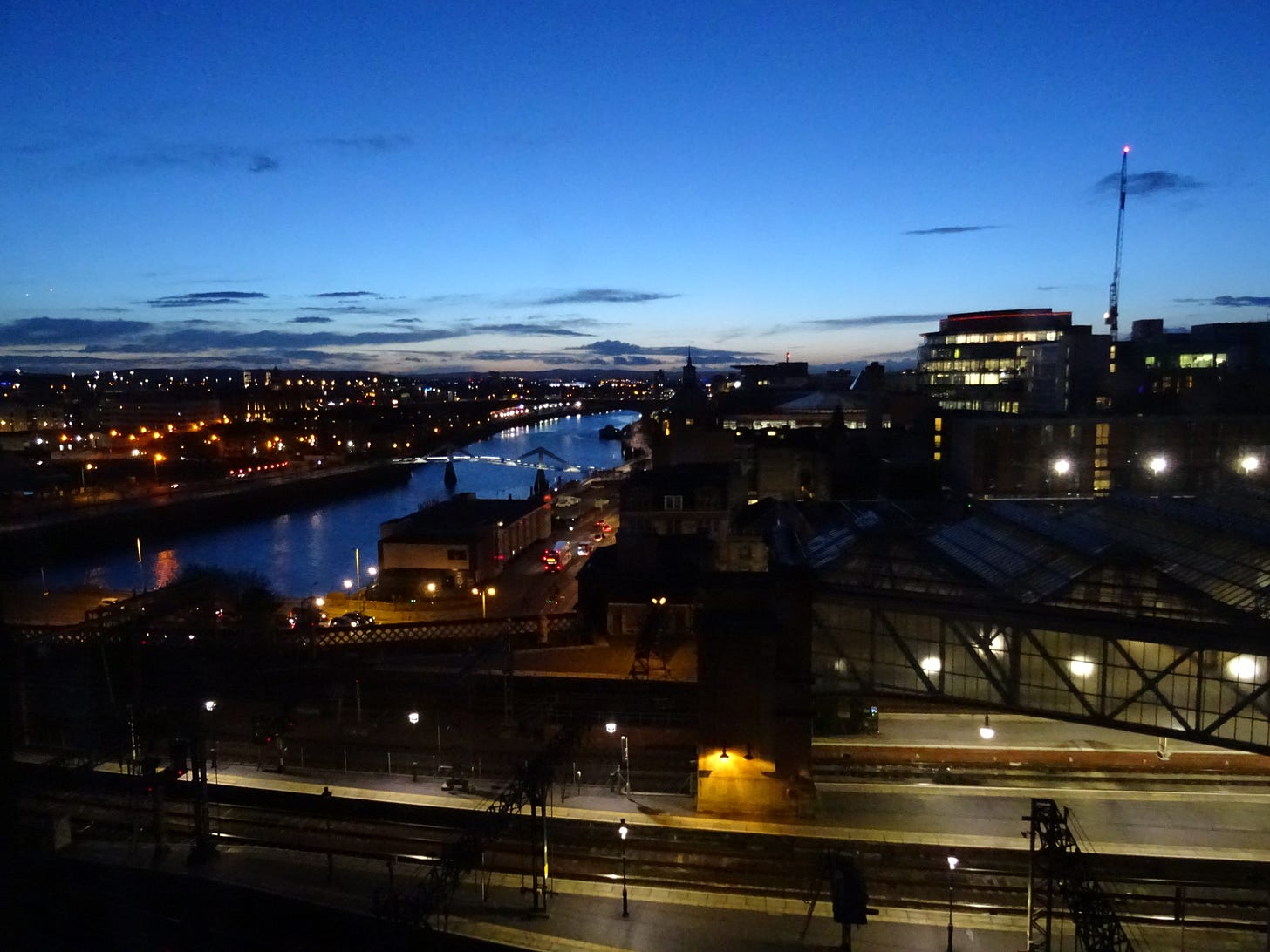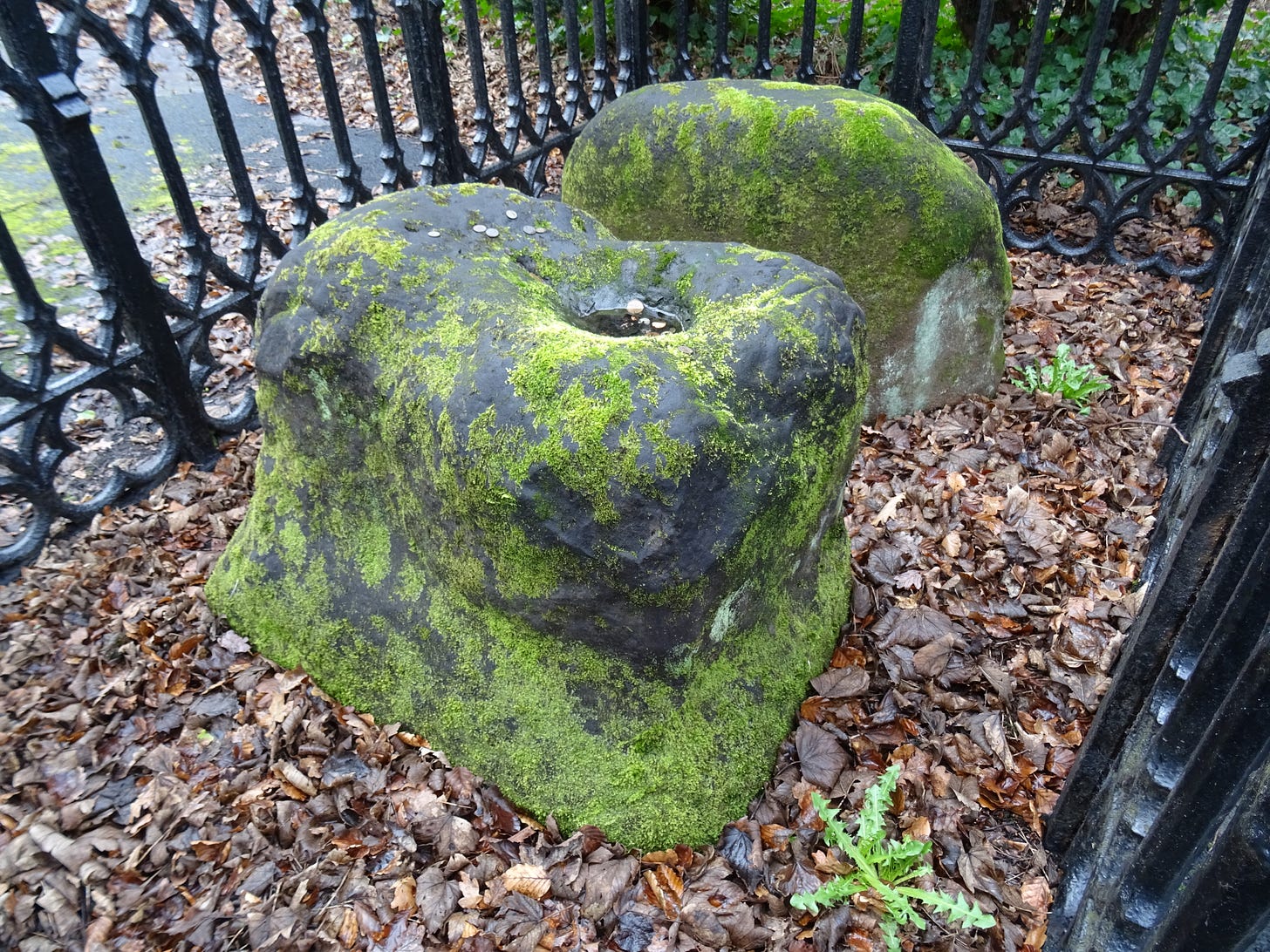As I mentioned in last week's post, Glasgow is a city of a great many buskers of all styles; young men with guitars and great voices seem to do well here. The first one of these that I saw was not far from Glasgow’s Central Station, his pitch laid out in front of the Gordon Street Coffee Shop next to the Blue Lagoon Fish Bar.
He stood in his skinny black jeans, denim jacket and woolly hat belting out covers of hits from the last twenty years through his amplifier as the crowds streamed by. I was happy to throw a pound into the optimistic suitcase open at his feet and stand awhile to listen. I may have been a little less happy when I got to my room and discovered that he was directly below my window and seemed to have incredible stamina when it came to singing and strumming.
JFK, Winston Churchill and Frank Sinatra
I was staying in the Central Station Hotel which is an opulent, wood-panelled place which has hosted JFK, Winston Churchill and Frank Sinatra but I don’t think they got the room over the fish bar. The architecture is impressive with one of the most stunning staircases I have ever seen. Not that I go around spotting staircases, but, honestly, it’s incredible.
The hotel was built by the Caledonian Railway in 1883 and was designed by Robert Rowand Anderson. A typical Victorian Scot with a large moustache, think Arthur Conan Doyle’s body double and you’ll be picturing Bobby Anderson, he had also been the architect of the railway station. There aren’t many railway stations that are worth visiting if you are not catching a train, perhaps Grand Central Station in New York and St. Pancras in London, but this one should be added to that list – if you’re making one.
It was extended and rebuilt just after the turn of the twentieth century, so it’s hard to see exactly what Rowand Anderson was responsible for, but the massive main concourse is covered by acres of iron girders and glass and a huge, glass-walled bridge carries the station over Argyle Street. The old ticket office, which today houses Boots the Chemist and a Marks and Spencer food shop, is a huge, two-storey oval building.
You can see parts of the station from the hotel and there can’t be a more central place to stay in Glasgow, it certainly was at the heart of things. If New York is the city that never sleeps, then Glasgow is the city that stays up late shouting obscenities then gets up early to make deliveries, loudly. Not as catchy but more true than the Big Apple’s epithet.
A Lady from New York
I met an elderly lady from New York once in a hotel lift. When I say I met her, our journey in the lift down three floors was the extent of our relationship. During this journey she informed me, out of the blue, that the worst thing about Edinburgh was that you couldn’t use an umbrella. This is an odd thing to inform someone of, seemingly at random. It is even odder if, at the time, you are in Glasgow and it isn’t raining, both of which were the case. Perhaps she was a secret agent and this was some kind of code. Maybe if I had answered “The doves fly backwards at midnight”, I’d have ended up, like Holly Martins, being threatened on a Ferris wheel in Vienna or, like Harry Palmer, I’d wake up in a prison cell in Albania.
Apart from Albanian prisons, I love waking up in places I don’t know. I enjoy that moment of uncertainty when you wake up and the world is rather fluid and you can’t quite put your finger on which city you’re in. I love not being familiar with what’s on the other side of the curtains. I even enjoy waking up on a wet morning on the Clyde.
Night Like Treacle
Dark at ten past six, the night like treacle on the platforms of Glasgow Central Station ten floors below. The early blue and red and cream trains clunk in and out, their empty carriages lit for no-one. The first of the day’s traffic on George V Bridge and Broomielaw; the M8 already busy with trucks. Long lights from the city reflect in the Clyde. Gulls screech over the sounds of the trains and traffic. This may well be the only morning in my entire life that I wake up right here, so I notice all of these things.
If only I had the sense to notice every morning in as much detail, to mark it as something special, to appreciate the splendour of the mundane. How many mornings have gone and are forgotten? I might have thirty thousand mornings in my life but will recall only a handful. A few Christmases as a kid, some days on holiday, the day I got married and this morning in Glasgow. Tomorrow I won’t wake up here, one day I won’t wake up at all, it is crazy not to mark each day as a little miracle, the miracle of just being alive.
Glasgow’s Palaces
Glasgow is a truly wonderful city to walk around, with surprises everywhere, Bill Bryson, who can prove somewhat difficult to extract a compliment from, called George Square: “the handsomest in Britain” and he’s not wrong. Walk from the station to the River Clyde and cross the South Portland Street suspension bridge, a narrow pedestrian bridge spanning the water, and ahead of you is Carlton Place and its splendid three-storey stone buildings. Several of them are abandoned and boarded up but a better spot in any city it is still not easy to find.
Glasgow has some amazing buildings, from these forgotten beauties to the splendour of the old Templeton carpet factory, modelled on the Doge’s palace in Venice. Today it is what is called a “lifestyle village” which, I think, means some flats and a restaurant. Nearby is the People’s Palace, a red sandstone building housing a museum of the city. On the back of this is a gigantic, a truly gigantic, conservatory where you can stroll among tropical plants and palm trees, in precisely the way you’d not expect to do in Glasgow. Outside is a park full of avenues of trees and monuments and statues. They really don’t tell you this about Glasgow, do they?
Leaving the People’s Palace by the front entrance, past the terracotta Doulton fountain, is the district of Glasgow known as Calton. This is, perhaps, more what you may have expected from Glasgow with blocks of flats and empty shops with peeling paint on the upper floors. Here you can get a tattoo, buy a bearded dragon and eat haggis pakora, haggis fritters or haggis pizza seven days a week. This area is sometimes called the Barrowlands because it’s the site of the famous market, The Barras, which is supposed to be bustling and bursting with bargains from Wednesday to Monday every week. I think I must have visited on a Tuesday.
Council Tenants and the Dead
The High Street leads you north and to the very best view in the city, the one painted by John Houston (not the film director). Glasgow reserves its very best views for council tenants and the dead. If you don’t live in one of the high-rise blocks of flats dotted around the edge of town then you have to climb past the cathedral to the Necropolis. From here you can still get John Houston’s view of the city and the cathedral. St Mungo’s Cathedral is the only cathedral in the whole world named after a cartoon dog, except for St Spike’s and Tyke’s in Siena. The Necropolis is where the great and good of Victorian Glasgow ended up.
The low hill behind the cathedral is littered with graves and columns and monoliths and obelisks and statues of dead men with mutton-chop whiskers including John Templeton and James Stewart Templeton of carpet factory fame. H.V. Morton called it “one of the most remarkable sights in Glasgow” and, in a city jam-packed full of things worth remarking on, he was right again. There’s nowhere quite like it in the British Isles as far as I know. It’s not just a graveyard, it’s a city of the dead, Glasgow’s dead. The people who built this amazing place both figuratively and literally still watch over the modern city.
It’s not just Glasgow that is wonderful, there are many truly fantastic places very close by. For instance, the village of Inchinnan just across the Clyde. In the late sixth century, St Conval is said to have sailed here from Ireland on a rock. I was unsure about what type of rock might make a suitable vessel for such a journey and so I visited the Normandy Hotel in Renfrew in the grounds of which sit, protected by gothic, black iron railings, two stones. One of which is said to be the base to an ancient cross, called the Argyle Stone, and the other is called “St. Conval’s Chariot”. I have to say, it didn’t look significantly more buoyant than any other large rock to me but I am no theologian or even a geologist; though I bet a geologist would back me up on this.
Half a mile from here on a small hill beside Black Cart Water, St Conval established a church which would later be known as All Hallows and where his shrine would be located. Six centuries later a medieval church was built on the site and granted to the Knights Templar by King David I. When the Templars were disbanded two centuries later, the church was passed on to the Knights of St John. Another church was built here in the early nineteenth century and when the floor of the old church was lifted it was found to be paved with skulls. Seventy or so years later Archibald, the first Baron Blythswood, decided to update the church and engaged Sir Robert Rowand Anderson, who we first met at the Central Station, to design the new one.
The Templar Stones
Lord Blythswood was an interesting chap who served in the army during the Crimean War, was Member of Parliament for West Renfrewshire and designed a propellor for aeroplanes before there were any aeroplanes to propel and while the Wright Brothers were still fixing punctures. Unfortunately, the church he had built only lasted for sixty years and was demolished to make way for Glasgow Airport in 1965. Some carved stones from the tenth and eleventh century plus some gravestones, including what are known as the Templar Stones, were moved to the new church in the village of Inchinnan.
Keep reading with a 7-day free trial
Subscribe to Bunking Off to keep reading this post and get 7 days of free access to the full post archives.









